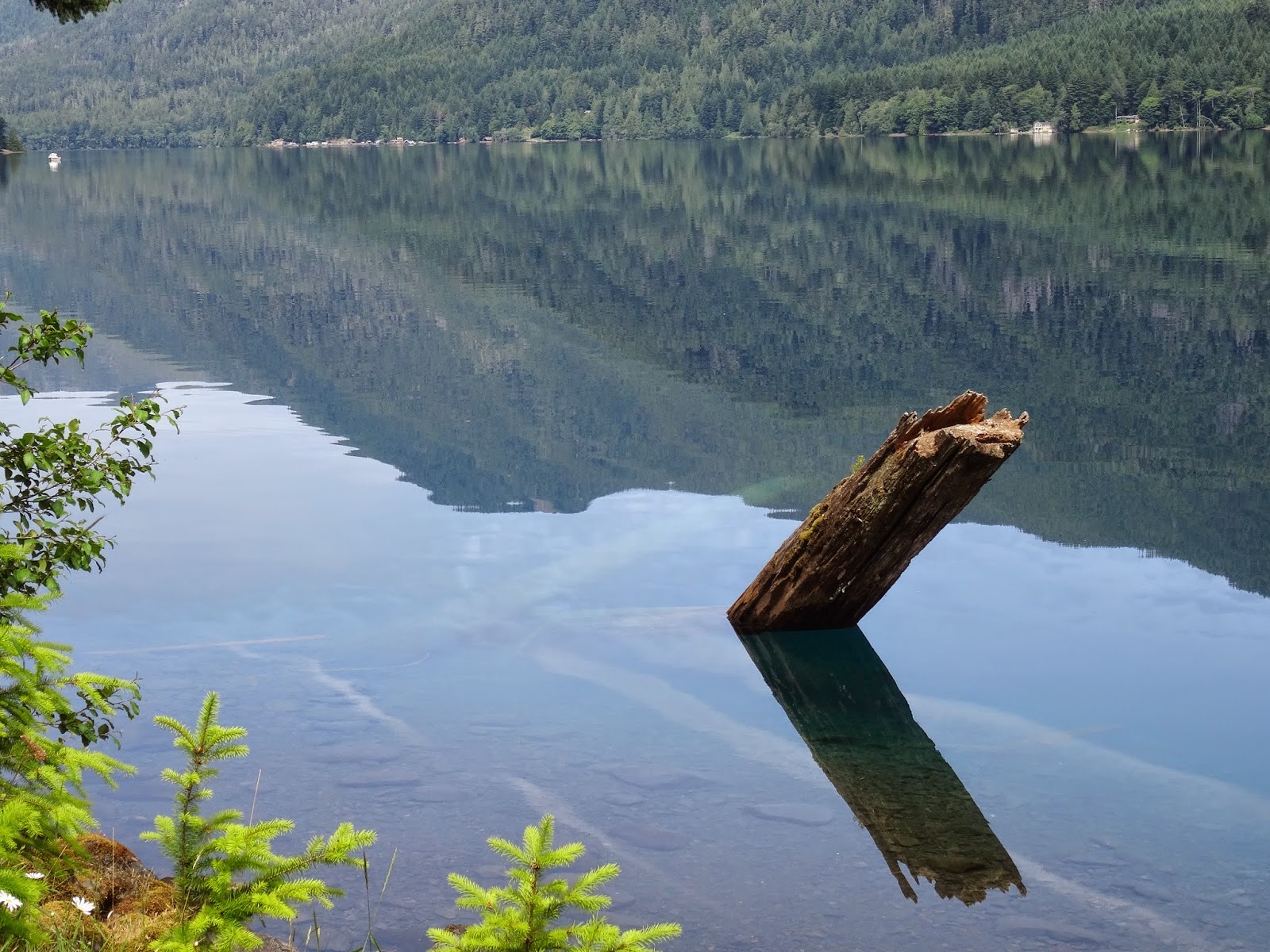 |
| Aboard the ferry "Salish" to Whidbey Island, I caught this nice pattern of shapes and color before we departed. |
At any rate, I went to this piney woods often in the summertime. It was quiet, and there were some huge boulders that had gotten pushed into each other, creating a cozy little hide-away, filled with needles and leaves and cones from winds and previous seasons, in between them. (I know I didn't go there much after I was 10 or 11 because I was too big to fit in that space anymore.) It was my enchanted forest, where fairies and gnomes and my mystical life got nourished.
 |
| On this grey day, the canopy of trees took on a lovely pattern only seen when one looks heavenward. |
Once, when returning from the boulder site, I came up a path and was face-to-face with a doe and her two rump-spotted fawns and an 'auntie,' and I think a yearling. They stopped and looked at me, sniffing the air, and I was transfixed with the beauty of the group, standing breathless watching to see what was going to happen next.
It was one of those moments in time that seem to stop clocks... the world might have even stopped spinning as we faced each other. A crack of a twig somewhere broke the silence. We all looked in the direction of the noise and there was the male, leader of the herd, fully antlered, coming to check on his girls.
There was no fear anywhere. We all sort of nodded at each other. The deer clan headed calmly off to the nearby field for grazing, perhaps to the place where I knew berries were nearly ready, and I sank to the ground, exhausted by the exhilaration of being so close to creatures I had read about.
 |
| 72-acre Earth Sanctuary is located on Whidbey Island, off Newman Road. It is $7 per person and $1 for the guide. |
 |
| Fallen trees also serve as homes for the wildlife. |
Yesterday I walked through a nature preserve, the Earth Sanctuary, on Whidbey Island that is privately owned and maintained. This forest fed me with the same etheric energy of my childhood. I returned home refreshed, cleansed and totally exhausted from it, sleeping two and half-hours, getting up for dinner and then falling into another wonderful and restful sleep until the six o'clock bird-fest outside my window woke me up.
This 72-acre Sanctuary is not unlike that of Willard Pond, another precious bit of protected land that our family gave over to New Hampshire Audubon to manage. I grew up appreciating the dangers of avarice for beautiful ponds and my grandmother Elsa dePierrefeu's wisdom created a 1700-acre wildlife preserve that still today offers the pavement-weary soul a place to retreat, repair and renew one's energy.
The wooded wetlands of this private land have over 80 species of native plants, including some delicious-looking red and yellow raspberries. (No, we did not take any. We did not see a sign that said we could not, but we felt we were on sacred ground and should leave the fruits of it to the residents; the deer, the birds, the beavers and muskrats and other critters that call this home.)
 |
| Raspberries are coming to fruit all over Washington now. |
 |
| Ponds and bogs each have their role to play in nurturing a healthy forest environment for all creatures, including slugs, which are my least favorite creature overall. |
 |
| I have never seen this fruit in the marketplace, but went to a class recently to learn how to grow them at home. |
 |
| The trail to the left leads to first Medicine Wheel area while the trail to the right leads to the ponds and the Labyrinth and Prayer Stone, more easily accessible. |
 |
| Tibetan Prayer Wheel |
 |
| Cottonwood Stone Circle |
If you are planning to experience the Medicine Wheel section, be prepared to remove your shoes, carry some fresh tobacco for an offering, and either matches or a lighter to light it. At the time of our visit there was some tobacco and some sage for smudging, but the matches were wet. Also, no photographs are allowed of this sacred place, so please do not violate Native American customs by taking any.
 |
| Path is wide, but has a significant incline in both directions. A bit challenging for wheeled chairs or folks with walking issues. |
 |
| There are plenty of places to sit and meditate in the area. |
 |
| Visitors to the Stupa/Tibetan prayer location can use the prayer wheels and the gong to enhance the experience. |
You can visit the Sanctuary on a day-trip basis or stay at the Retreat building on site. For more information, go to earthsanctuary.org.
If you don't have email or internet access, you can phone Celia at 360-321-5465.


















